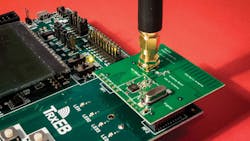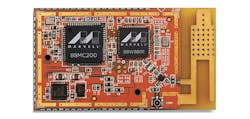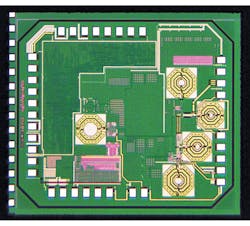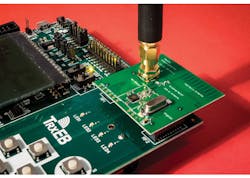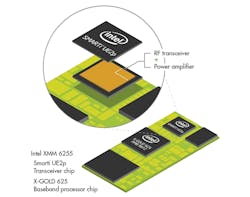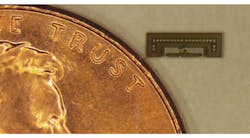9 IoT-Enabling RF Transceivers
Download this article in .PDF format
Many science-fiction authors have predicted a time when urban environments will be intelligently interconnected and share a wealth of information. If that statement gives you flashbacks of the movie
“Minority Report,” your vision is pretty accurate by current estimations (minus the crime-predicting psychics). Given the many advantages of a connected world, many companies and hobbyists are working hard to enable the latest interconnecting technologies (Fig. 1). Dubbed the Internet of Things (IoT) or Internet of Everything (IoE), this movement requires a diverse amount of sensors and wireless-communications technologies that only occupy a small footprint and require very little power (Fig. 2).
Modern implementations of high-level communications protocols are paving the way toward the development of a Web of personal-area networks (PANs) that will rely on ever-more integrated microprocessor and sensor platforms. These technology forebears include Wi-Fi, Bluetooth, ZigBee, 3G/4G/LTE cellular technologies, and custom RF-transceiver technologies. For IoT-driven applications, critical factors include size, weight, power, and cost (SWAP-C). Yet frequency, modulation protocols, and intelligence also are key. Because there are many tradeoffs between these parameters, the latest IoT devices have become highly integrated devices. Often, they include the complete device in one module or chip.
In response to the rise of the emerging wearables market, for example, the Bluetooth Special Interest Group (SIG) developed a low-energy version of its classic protocol, called Bluetooth LE or Bluetooth Smart. This technology uses a simpler modulation scheme than classical Bluetooth to ensure greater communications efficiency. It still operates in the industrial, scientific, and medical (ISM) band from 2.400 to 2.485 GHz.
In addition to the advantage of Bluetooth’s highly resilient, adaptive-frequency-hopping scheme, these advances enable many devices to be equipped on an essentially plug-and-play transceiver platform. This platform can perform machine-to-machine (M2M) or machine-to-human-interface communication. Bluetooth Smart reportedly consumes 0.01 to 0.50 W to 100 m. It transfers data at speeds to 1 Mb/s with a latency maximum of 6 ms.
ZigBee is another low-power PAN technology built on the IEEE 802.15 standard. It is best suited for low-data-rate applications that require long battery life and secure networking. The ZigBee standard has a defined data rate of 250 kb/s and a range to 20 m. Although data can be transmitted over longer distances using mesh networks, ZigBee is best suited for intermittent transmission. These factors make ZigBee a lower-power solution than other PAN technologies, such as Wi-Fi and Bluetooth Smart.
Unlike both Bluetooth and ZigBee, the IEEE 802.11x Wi-Fi standards are designed to provide a high-data-rate wireless-local-area-network (WLAN) platform. Many Wi-Fi standards operate at the 2.4-GHz ultra-high-frequency (UHF) and 5.0-GHz super-high- frequency (SHF) bands to escape the spectral clutter in the UHF bands. There are even sub-1-GHz Wi-Fi standards for operating in the 900-MHz unlicensed bands. In addition, the 60 GHz standards—commonly known as WiGig—enable extremely high data rates in unlicensed bands in the millimeter waves.
Typically, Wi-Fi’s range extends to 35 m indoors and 100 m outside. Yet the higher-frequency Wi-Fi standards suffer from reduced range. Because W-iFi technologies are very adaptable and present in many urban environments, they could benefit IoT applications by providing high-data-rate capability and interoperability with many pre-installed network systems.
Future-Looking Products
The transceivers developed with the IoT in mind leverage these various communications technologies. CSEM’s icycom, for example, is a custom 900-MHz ISM-band IoT system-on-chip (SoC) transceiver. The firm also offers a 2.4-GHz version in the icyTRX (Fig. 2). Both devices are designed for battery-powered body-area networks (BANs), wireless sensor networks (WSNs), and automation applications. They can operate from a power supply down to 1 V.
The icyCom consumes 3.5 mA of receive current and 40 mA of transmit current with a +10-dBm continuous output. Its sibling, the icyTRX, consumes 5.3 mA of receive current and 8.3 mA of transmit current. In doing so, the icyTRX exceeds Bluetooth Smart’s and ZigBee’s low-energy requirements.
The icycom offers an RF data rate of 400 kbps with receive sensitivity to -115 dBm. In contrast, the icyTRX boasts receive sensitivity as high as -90 dBm at 4-Mbps data rates. Because it is difficult and costly to fit all RF matching circuitry at sub-1-GHz frequencies, the icycom may require additional matching circuitry. That is not the case, however, for the icyTRX. The icycom module measures 1 cm. The icyTRX is offered in a 2-mm silicon die. While the icyTRX features a serial peripheral interface (SPI), the icycom features SPI, UART, I2C, I2S, and GIPO interfaces.
Another example of a sub-1-GHz transceiver module is Texas Instruments’ RF430F5978 MSP430 SoC. It incorporates the CC1011 RF transceiver operating in the 315/433/868/915 ISM/SRD bands (Fig. 3). The SoC features a low-frequency (LF) wakeup and transponder interface. It consumes just 15 mA at 250 kbps and 915 MHz while providing receive sensitivity to -117 dBm and transmit output power to +12 dBm on all supported frequencies. The SoC flaunts a 12-bit analog-to-digital converter (ADC) and numerous sensors and interface capabilities. The SoC network co-processor (NCP) that was recently introduced by Silicon Labs is based on ZigBee and equipped with an ARM Cortex M3 central processing unit (CPU).
The EM35x and EM358x chips employ a ZigBee IEEE 802.11.4 transceiver and 32-bit microprocessor with built-in Flash and random-access memory (RAM). They boast selectable power amplifier (PA) output to +8 dBm and receive sensitivity to -102 dBm. The SoCs consume just 26 mA receive and 31 mA transmit power in standard operating conditions. The integrated voltage-controlled oscillator (VCO), PA, loop filter, and regulator help to reduce overall device size and part count.
Marvell recently developed both a low-power Wi-Fi SoC, the 88W8801, and the 88MZ100 ZigBee microcontroller unit (MCU). The ZigBee SoC uses a 32-bit ARM Cortex M3 to drive a wide range of interconnectivity peripherals. Due to the low-power nature of the ZigBee technology, the 88MZ100 operates at a low clock rate and has less advanced internal sensor technologies. However, it is capable of operating on a 2-V supply using its integrated DC/DC converter.
For its part, the Zigbee SoC has minimum receive sensitivity of -104 dBm and consumes 14 mA of receive current. It offers adjustable transmit power to +9 dBm while consuming minimum transmit current of 26 mA. The IEEE 802.11n single-band Wi-Fi SoC, the 88W8801, is equipped with an on-board PA, low-noise amplifier (LNA), and transmit/receive switch for adjustable system performance.
Recognizing the advantages of integrated RF transceiver and microcontroller-unit SoCs, Analog Devices moved to also include a low-power analog input/output. The ADUCRF101 employs a six-channel, 12-bit ADC powered by a 32-bit ARM Cortex M3. Among the communications peripherals and serial peripherals interfaces supported are SPI, UART, GIPO, PWM, and I2C. The RF transceiver operates in the ISM unlicensed 431-to-464-MHz bands and 862-to-928-MHz bands. The SoC can operate from a 2.2-V power supply. It has several power modes for ultra-low power-off-state standby at 280 nA and a memory retaining 1.9 μA mode. In receive mode, the transceiver consumes at least12.8 mA. It consumes 9 to 32 mA in transmit mode.
Leveraging Existing Infrastructure
Using pre-existing cellular-telecommunications structures, such as 3G/4G/LTE, to enable the IoT could ensure mobility and reliability while providing the added benefit of security (Fig. 5). Because many areas do not possess the necessary density of relatively short-range Wi-Fi, ZigBee, and Bluetooth networks, using a longer-range technology also could enable a much greater assortment of remote IoT devices. Intel recently made headway into a potential IoT platform with a 3G cellular modem measuring just 300 mm. The Intel XMM 6255 is designed to operate with small-volume antennas that are suboptimal for mobile-phone standards. Reaching 7.2 Mbps, it can support both 3G and 2G connections as well as Intel’s 65-nm CMOS process.
The XMM 6255 houses a PA to speed design and development time. Intel has also released a dual-core computer with IEEE 802.11a/b/g/n and Bluetooth 4.0 on-board/external connectivity. This 35.5-×-25-×-3.9-mm SoC, called the Edison, sports dual 500-MHz Intel Atom cores and a 100-MHz, 32-bit Intel Quark processor. It boasts 1 GByte of LPDDR3, POP, and RAM as well as 4 GBytes of eMMC memory. Running Yocto Linux 1.6 with ARduino IDE support, the Edison has GPIO support for USB 2.0 OTG, SD, UART, I2C, SPI, I2S, and PWM interconnects. Standby power without radios is 13 mW, but that increased to 21.5 mW with Bluetooth and 35 mW with Wi-Fi, according to Intel. With the advent of tiny and invariably portable computers that can control and report from many sensor/actuator systems, many complex IoT applications are coming closer to fruition.
For the more distant future, researchers from Stanford University and the University of California, Berkeley—in collaboration with STMicroelectronics—have developed a prototype for a millimeter-wave SoC that is fully equipped with an on-board radio and processor (Fig. 6). This micro-miniature radio device operates on 24 and 60 GHz with its transceiver. It is powered solely from background RF radiation. Currently, the range of the SoC is 500 mm. Although this may seem limiting, one must keep in mind that the module could potentially only cost a few cents to manufacture. With such a low-cost and small-footprint technology, many small sensing and control IoT applications could be unleashed.
As the techniques behind producing highly integrated and intelligent radios advance, SWAP-C characteristics will continue to drop. These trends also may be impacted by the decreasing size of silicon and the potential of carbon-based technologies, such as graphene and carbon nanotubes (CNTs). Meanwhile, software-defined-radio (SDR) technology is advancing. Soon, the industry will witness new levels of integration and low power consumption, which will result in very advanced, hybrid computer radios.
About the Author
Jean-Jacques DeLisle
Jean-Jacques graduated from the Rochester Institute of Technology, where he completed his Master of Science in Electrical Engineering. In his studies, Jean-Jacques focused on Control Systems Design, Mixed-Signal IC Design, and RF Design. His research focus was in smart-sensor platform design for RF connector applications for the telecommunications industry. During his research, Jean-Jacques developed a passion for the field of RF/microwaves and expanded his knowledge by doing R&D for the telecommunications industry.
